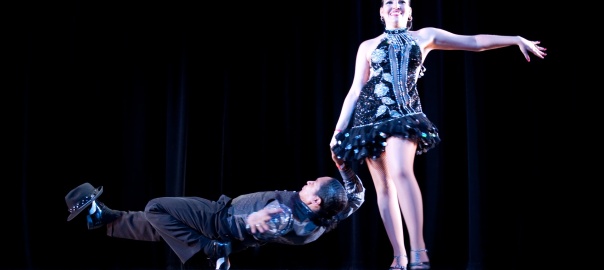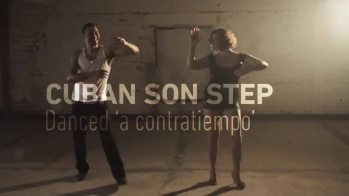-

WHY EVERY CASINO DANCER SHOULD LEARN TO DANCE SON, TOO
- Based upon -
( condensed from - revised - - with corrections, modifications and (additions ))
WHY EVERY CASINO DANCER SHOULD LEARN TO DANCE SON, TOO
by Daybert Linares Díaz - : "I"
If you were to attempt to trace the roots of the dance of casino, there are three main dances which you will hear mentioned time and again:
danzón,
chacha
son
—
mambo (the Cuban one) and
swing also played a role.
Now, out of these three main dances which compose casino’s genealogy,
in Cuba danzón is seen as more of a “senior dance”—that is, a dance more suited for the older generation.
Chacha immensely popular during its “fever” period—the 50s—
(( has survived as a dancers' social dance. ))
Out of the three dances, it is son that has survived the most the test of time as a Cuban social dance. ...son is the one which has a closer resemblance to casino, the most popular Cuba partner dance to date. (... casino is often danced to son music. )
there is certainly a lot to be learned from son that would definitely benefit your casino dancing, as well as the way you approach the music to which you dance casino.
Let us start with the dance first.
If you learned casino the way ...a lot of people are taught casino nowadays, you probably know is a series of turn patterns. That’s mostly what they teach at academies—turn patterns. (... ( not at any of the places we deal with ... ))
... one of the great things about casino—and this is due to son’s influence—is that you have the ability to move around the room with your partner while dancing. You could start on one end of the room when the song begins, and finish on the other, when it ends.
The following video is a good example of that.
thesepaseos—Spanish for “strolls”, which is what this moving around is called—are easily transferable to casino dancing, and at times transformed in novel ways, like in this video (notice how he also incorporates the son tornillo, the move where the man stays in the same place while the woman walks around him, rotating him:
... in Cuba moving around the room while dancing and shimming the shoulders is commonplace.
Salsa Lovers’ DVDs .. impact on casino here.) The following video, taken at a Salsa Lovers’ dance social, exemplifies this. Notice how nobody moves around the circle while dancing. It’s all about how many turn patterns they can get in in the twenty or so seconds they are allowed to shine in front of the others:
Now, you may be a casino dancer who is already doing these paseos, ... ?
 The other great thing about adding son to your dance repertoire is that you will learn how to dance on contratiempo. Contratiempo means “against the beat.” The beat is the one count, so dancing on the beat is referred to as dancing a tiempo (on time).
The other great thing about adding son to your dance repertoire is that you will learn how to dance on contratiempo. Contratiempo means “against the beat.” The beat is the one count, so dancing on the beat is referred to as dancing a tiempo (on time).
Therefore, when you dance against the one count (the beat), you’re dancing on the two (
Son is traditionally danced on the two; (( - 2 - after the Clave - ? - 3 - to western ears ))
... you (( may have )) have attended in the past a son workshop where the instructor played the clave and taught you how your steps fit into the pattern of the clave, and then called it dancing “on contratiempo”
So what makes it important to learn to dance on contratiempo? Well, besides it being the count on which you dance son, it also has to do with musicality reasons. In a previous post, I talked about the structure of a son song:
it has a largo (a slower, introductory section), and
a montuno section, which is more upbeat than the largo.
... musicians dance the largo on contratiempo. Take the video below as an example.
This Bamboleo song is what most people would call “timba” and not really associate with son music. But if you look closely at when on the beat the singers are dancing during the largo—in this song, until 1:09 or so– you will notice that they are dancing on the two. After 1:09, you will see that they are doing their three-step on the one.
...Take a look at this Klimax video. The exact same thing happens:
... musicians understand that there is a difference in each of the two sections of the song, not only as it pertains to how each instrument gets played during each section, but also on what count to dance.
Notice that, in the following video, ( I - DIAZ - ( not us )) dance on the two (and incorporate thepaseos from son) during the largo, which ends at 1:28,
then switch to dancing on the one when the montuno comes in,
then back to the two at the end of the song,
when it starts slowing down the tempo again as it comes to an end—in fact, the person recording points it out.
Dancing casino on the two, or contratiempo—a concept from son, not casino—allows you to better interpret the songs when you dance to them (again, the musicians who make this music know this). Once you learn contratiempo and begin trying to dance to the largo of the song on the two, you will see a very big difference on how it feels to dance it on that count, and how much more it goes with what the instruments are doing, or what sounds stand out—specially with the bass and the congas.
... traditional son music l
Septeto Nacional,
Sierra Maestra,
Pancho Amat, or
Septeto Santiaguero.
... ? .. there is a divide between the music that gets played at casino socials (timba, mostly) and
salsa socials (salsa/mambo). ???
...
...
(( note - We play Salsa, Timba, Mambo, Cha Cha , ... at our socials ... ... ))
... people in the 1960s in Cuba had to be dancing casino to something, ...? ( ... casino was developed in 1957.)
I had found a way to dance to the music that they played at salsa socials. And the answer was son.
Learning to dance son will not only help you when dancing to “that mambo” or “that salsa” music that you may not like because of all the timba you have been primed to listen to and made to believe that that is the only music the Cuban dance community dances to, it will also help you realize that there is a lot stuff you’re missing out on.
“Timba” is just one part of the picture, not the picture itself.
The other day I made a post that consisted simply of a list of ten songs made by Cubans but that do not really “make the cut” at Cuban dance socials and or events because they sound too much like the stuff they play in the salsa scene. This is one of them
The reason that happens is not because these songs borrowed from salsa, but rather the other way around, as these songs were all composed and performed prior to the 1970s,
...these songs are Cuban.
.. learn to dance son, not only because it will help your casino, by giving you new moves you can incorporate into the dance, or allow you to better interpret, musically, the songs to which you are dancing. Do it, too, because, without son, there is a ton of great music, also made in Cuba, to which you will never get to dance.
-
Original text -
-
https://plus.google.com/u/0/b/110656406334925802455/110656406334925802455/posts
-
https://sonycasino.wordpress.com/2015/01/13/
why-every-casino-dancer-should-learn-to-dance-son-too/
No comments:
Post a Comment